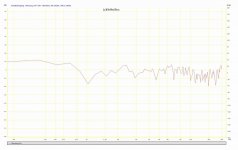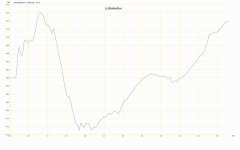But while you're here: how are you coming along with the elliptical waveguide? One day I'd like to own loudspeakers that allow me to remove absorption from the floor and the ceiling.
Advanced development is completely stalled - I am swamped with work. I had a guy helping but now I don't, so I have no target date. I have changed the cabinet and crossover design on the Abbey.
Is there any polar data available for that speaker?
Best, Markus
Your kidding, right?
Advanced development is completely stalled
That's bad news.
Is the data on your website already from the 12a version? By the way, please fully label your diagrams. People might link them from other places and important information will be lost.
Your kidding, right?
Well, it's pretty pointless to buy a loudspeaker that claims to have certain characteristics without showing these characterisctics in a meaningsful way. "The new Porsche Boxter Spyder has hundreds of horse power" - would anybody accept that kind of specification?
That's bad news.
Is the data on your website already from the 12a version? By the way, please fully label your diagrams. People might link them from other places and important information will be lost.
No. The looks will change, but not so much the performance, but there are two changes that make a little difference - the crossover and a larger foam plug. I have not posted the results from these yet - again, no time.
I dont follow "please fully label your diagrams"?
An externally hosted image should be here but it was not working when we last tested it.
What does each frequency response represent? Smoothing? Is the impuls gated?
Is there any polar data available for that speaker?
how dare You to ask such questions? 😉
after all it's "25cm W by 49cm H by 31cm" Transmission Line with OptiSlope crossover (60 dB/octave) 🙄


Hi,
I took some off axis curves when I measured, but I do not have a nice turntable. When I get around to measuring them again I might spend more time on the off axis response.
As for the "kidding part", using the same approach characterising the speaker speaker as I did in my long gone pro-audio days I'd call the HF/Upper-MF unit 60 Deg (H) X 20 Deg (V). Directivity is actually quite constant for this planar/horn combo, after equalising the (expected) HF rolloff up to around 15KHz and down to the X-Over frequency.
Due to the relatively large diameter LF unit we have a reasonable seamless link in terms of off-axis response in the horizontal plane, in the vertical plane there is a pretty serious step, but it seems to cause not all that much trouble (contrary to expectations).
Still, things get a little more interesting when two units are stacked tweeter to tweeter with the fairly significant distance of the LF units now producing some substantial reduction of vertical dispersion angle.
Hence my take to use two of my LF units in MTM around a very large magnetostat/horn combo to get a better match of directivity in the vertical plane.
It is not a transmission line. Nor does it say it anywhere that it is a transmission line. It says "Transmission Line Port", which is a nickname that got stuch due to the way that port is folded up, similar to a TL.
As for the 60dB/8ve, that is real. And the step response still does not look too shabby. 🙂 I find that the worst crossovers are those with slopes that in-between. Fourth order acoustic seems especially bad from experience. I find no-xover (single way) or 1st order in most cases preferable. Where that does not work too well using very steep slope crossovers works rather well. You may want to try.
Ciao T
Is there any polar data available for that speaker?
I took some off axis curves when I measured, but I do not have a nice turntable. When I get around to measuring them again I might spend more time on the off axis response.
As for the "kidding part", using the same approach characterising the speaker speaker as I did in my long gone pro-audio days I'd call the HF/Upper-MF unit 60 Deg (H) X 20 Deg (V). Directivity is actually quite constant for this planar/horn combo, after equalising the (expected) HF rolloff up to around 15KHz and down to the X-Over frequency.
Due to the relatively large diameter LF unit we have a reasonable seamless link in terms of off-axis response in the horizontal plane, in the vertical plane there is a pretty serious step, but it seems to cause not all that much trouble (contrary to expectations).
Still, things get a little more interesting when two units are stacked tweeter to tweeter with the fairly significant distance of the LF units now producing some substantial reduction of vertical dispersion angle.
Hence my take to use two of my LF units in MTM around a very large magnetostat/horn combo to get a better match of directivity in the vertical plane.
after all it's "25cm W by 49cm H by 31cm" Transmission Line with OptiSlope crossover (60 dB/octave)
It is not a transmission line. Nor does it say it anywhere that it is a transmission line. It says "Transmission Line Port", which is a nickname that got stuch due to the way that port is folded up, similar to a TL.
As for the 60dB/8ve, that is real. And the step response still does not look too shabby. 🙂 I find that the worst crossovers are those with slopes that in-between. Fourth order acoustic seems especially bad from experience. I find no-xover (single way) or 1st order in most cases preferable. Where that does not work too well using very steep slope crossovers works rather well. You may want to try.
Ciao T
When I get around to measuring them again I might spend more time on the off axis response.
That would be very nice. 'Til then I keep on waiting for Earl's elliptical waveguide to happen.
Hi,
Your call. You may still want to have a look at (and listen to) the larger size and format pro audio magnetostats with waveguides. Quite a few actually have pretty good "Constant directivity" and high sensitivity coupled with decent power handling at prices that make them quite attractive.
And they sound like no compression driver I have heard ever did. It is hard to go back to anything else after you get used to these though.
Ciao T
That would be very nice. 'Til then I keep on waiting for Earl's elliptical waveguide to happen.
Your call. You may still want to have a look at (and listen to) the larger size and format pro audio magnetostats with waveguides. Quite a few actually have pretty good "Constant directivity" and high sensitivity coupled with decent power handling at prices that make them quite attractive.
And they sound like no compression driver I have heard ever did. It is hard to go back to anything else after you get used to these though.
Ciao T
Quite a few actually have pretty good "Constant directivity"
Again, any polar data available?
...
One day I'd like to own loudspeakers that allow me to remove absorption from the floor and the ceiling.
...
This one gets along with rather light absorption ...
Attachments
Hi,
Several I have been playing with had such data available, nothing I am at liberty to re-publish. I guess you will have to ask the driver manufacturer...
Ciao T
Again, any polar data available?
Several I have been playing with had such data available, nothing I am at liberty to re-publish. I guess you will have to ask the driver manufacturer...
Ciao T
Again, any polar data available?
No complete polar response data, but the -6 dB beamwidth of the Beyma AMT looks good:
http://profesional.beyma.com/ingles/pdf/TPL150H.pdf
Maybe Dieter Achenbach can give you the plots of the Limmer horn for the Stage Accompany.
What does each frequency response represent? Smoothing? Is the impuls gated?
Are you saying that this data needs to be on the plot? Physically in the picture?
No complete polar response data, but the -6 dB beamwidth of the Beyma AMT looks good:
As stated, horizontal is 80, +9, -20 That means it varies between 60 degress and 90 degrees. Thats CD? And 90 degress is way too wide. I stay with what I have thank you.
This one gets along with rather light absorption ...
Any polar data available?
Hi,
Several I have been playing with had such data available, nothing I am at liberty to re-publish. I guess you will have to ask the driver manufacturer...
Ciao T
No complete polar response data, but the -6 dB beamwidth of the Beyma AMT looks good:
http://profesional.beyma.com/ingles/pdf/TPL150H.pdf
Maybe Dieter Achenbach can give you the plots of the Limmer horn for the Stage Accompany.
I'm more interested how the whole speaker performs and not just one component.
Are you saying that this data needs to be on the plot? Physically in the picture?
Yes, shouldn't be too hard? black = 0°, red = 7.5°, etc
Any polar data available?
Unfortunately not, but i have a measurement which was made
with microphone on the bottom and in 150cm distance.
Since acoustic center is on ~130cm height for high freqencies,
this would correspond to about 40 degrees off axis vertically.
That speaker is not in the focus right now, but when i have got
some time i will do more measurements, serving for
comparation with my DMLs.
"Dipol 08" 40° off axis vertically, frequency response and step response:
----------------------------------------------------------------------
Attachments
Last edited:
- Home
- Loudspeakers
- Multi-Way
- The Advantages of Floor Coupled Up-Firing Speakers


